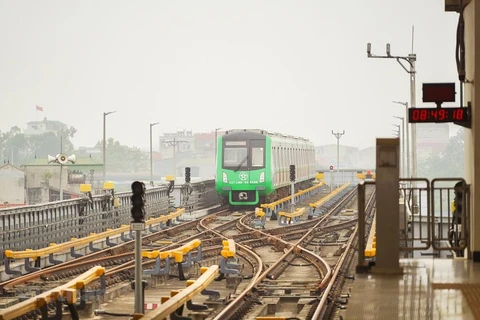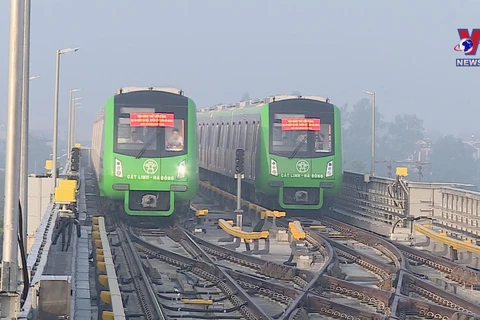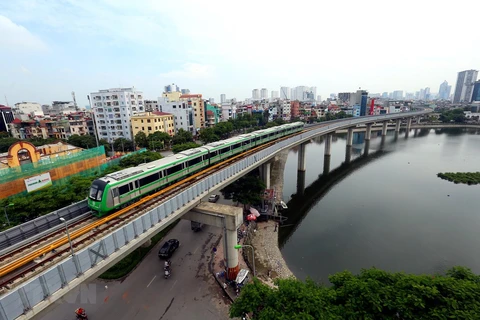Hanoi (VNA) – The Cat Linh – Ha Dong urban railway project is awaiting assessment from the State Inspection Council for the pre-acceptance test of construction works before being put into operation.
About the ìnformation that the French consulting firm Apave-Certifier-Tricc (ACT) issued a warning to the project, including those related to safety factors, the Ministry of Transport said the ACT granted a safety certificate to the system on April 29.
However, it also offered recommendations to several items that failed to meet European standards, including firefighting system, electric brakes, and workforce unready to deal with contingencies during the route’s operation process.
Explaining the issue, a representative from the ministry said when the project was signed, the safety assessment was unavailable in line with the Railway Law. However till 2017 when the work was finished, the law supplemented safety assessment regulations, prompting the ministry to hire a consultant as a third party to offer independent, objective and transparent appraisals. As a result, the ACT won the bid to become the consultant for the project.
The ministry also affirmed that the project was carried out under Chinese standards, from design, construction, acceptance to operation. Meanwhile, the ACT made assessment under European standards, leading to differences in terms of standards.
Late construction affects assessment criteria
The project had its design approved in 2010-2011 while several items assessed by the ACT require the latest technology.
Specifically, a safety certificate is only granted to the train control signal system rather than tractions, electric brakes and others under the Chinese standards. Meanwhile, the European standards require assessments for these items.
According to a traffic expert, there is no requirement for system safety assessment in Asian countries, including China.
As a general practice, countries will conduct inspection on each part such as construction and installation to ensure right volume and standards as designed. Following a trial run of 6-9 months without any problem, the system will be put into commercial operation.
The nature of system safety assessment is discovering risks and offering recommendations to prevent risks when operating. Such recommendations are still mentioned in the certificate, the expert said.
Awaiting acceptance before operation
A ministry leader said from January – March 2021, the investor and other units fixed problems as recommended by the ACT.
The operator, the Metro Hanoi Company, completed 64 emergency handling procedures, held rehearsals on site, and added signposts for persons with disabilities. It also hired a foreign consultant to support operation in a year.
Up to now, 13 trains have received technical safety and environmental protection certificates from the Vietnam Register and a certificate from the Vietnam Fire and Rescue Police Department. They also ran over 15,000km on trial.
In late April, the Transport Ministry’s Urban Railway Management Board and the Hanoi Metro Company handed over documents and completed asset review on site. The ministry and Hanoi authorities perfected measures to fix problems as recommended by the ACT.
The project has ensured technical standards as designed. Its acceptance dossier was sent to the State Inspection Council by the Transport Ministry in late April, said the ministry’s representative.
Acknowledging that Cat Linh – Ha Dong is the first urban railway line in Vietnam with new factors and complexities in technology and operation, the representative said the council members are conducting cautious, thorough and comprehensive assessment before reaching the final conclusion and transferring to Hanoi for commercial operation.
The Cat Linh – Ha Dong line runs 13.5km with 12 elevated stations, encompassing Cat Linh, La Thanh, Thai Ha, Lang, Thuong Dinh, Ring Road 3, Phung Khoang, Van Quan, Ha Dong, La Khe, Van Khe and Yen Nghia.
Each train has four carriages capable of carrying over 900 passengers, with the design speed of 80km/h but the commercial run’s speed would be capped at an average of 35km/h. It will have the frequency of one trip every two minutes and take 23 minutes to travel from Cat Linh station to Yen Nghia station, and vice versa. Travelling from one stop to another will take one minute with a break time of about 30-45 seconds.
Invested by the Transport Ministry, the project costs a total of 886 million USD after adjustments./.

























